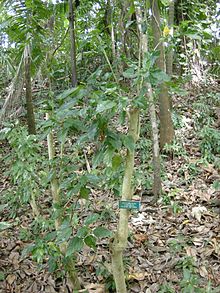- Hibiscus rosa-sinensis
-
Hibiscus rosa-sinensis 
Hibiscus rosa-sinensis 'Brilliant' Scientific classification Kingdom: Plantae (unranked): Angiosperms (unranked): Eudicots (unranked): Rosids Order: Malvales Family: Malvaceae Genus: Hibiscus Species: H. rosa-sinensis Binomial name Hibiscus rosa-sinensis
L.Hibiscus rosa-sinensis, known colloquially as the Chinese hibiscus, China rose and shoe flower, is an evergreen flowering shrub native to East Asia.
It is widely grown as an ornamental plant throughout the tropics and subtropics. The flowers are large, generally red in the original varieties, and firm, but generally lack any scent. Numerous varieties, cultivars, and hybrids are available, with flower colors ranging from white through yellow and orange to scarlet and shades of pink, with both single and double sets of petals. Despite their size and red hues attractive to nectar-feeding birds, they are not visited regularly by hummingbirds when grown in the Neotropics. Generalists, like the Sapphire-spangled Emerald, Amazilia lactea, or long-billed species, like the Stripe-breasted Starthroat, Heliomaster squamosus, are occasionally seen to visit it, however.[1] In the subtropical and temperate Americas, hummingbirds are attracted to them on a regular basis.
Hibiscus rosa-sinensis was named by Carolus Linnaeus. It has many names in Chinese: chijin 赤槿、riji 日及、fusang 扶桑、fosang 佛桑、hongfusang 红扶桑、hongmujin 红木槿、sangjin 桑槿、huohonghua 火红花、zhaodianhong 照殿红、songjin 宋槿、erhonghua 二红花、huashanghua 花上花、tuhonghua 土红花、jiamudan 假牡丹 and zhongguoqiangwei 中国蔷薇. Each of these many names is from a different state in China, each state having its own name for the plant. It also has prominent presence in the various part of Indian subcontinent. It has several names in different languages,Jaswand in Marathi, Bengali: জবা (Jaba), Sembaruthi-செம்பருத்தி in Tamil, Hindi: गुड़हल, Chemparathy - ചെമ്പരത്തി in Malayalam, Mondaro in Oriya,Wada Mal in Sinhala, Mamdaram (మందారం) in Telugu, Kembang Sepatu in Indonesia and Gumamela in Filipino.
Contents
National symbol
Hibiscus rosa-sinensis is the national flower of Malaysia, called Bunga Raya in Malay. Introduced into the Malay Peninsula in the 12th century, it was nominated as the national flower in the year 1958 by the Ministry of Agriculture amongst a few other flowers, namely ylang ylang, jasmine, lotus, rose, magnolia, and bunga tanjung. On 28 July 1960, it was declared by the government of Malaysia that the hibiscus would be the national flower.
The word bunga in Malay means "flower", whilst raya in Malay means "big" or "grand". The hibiscus is literally known as the "big flower" in Malay. The red of the petals symbolizes the courage, life, and rapid growth of the Malaysian, and the five petals represent the five Rukun Negara of Malaysia. The flower can be found imprinted on the notes and coins of the Malaysian ringgit.
Uses
Hibiscus flower preparations are used for hair care. The flowers themselves are edible and are used in salads in the Pacific Islands. The flowers are used to shine shoes in parts of India.It is also a pH indicator.China rose indicator turns acidic solutions to magenta/dark pink and basic solutions to green. It is also used for the worship of Devi and especially the red variety takes an important part in tantra. In Indonesia, these flowers are called "kembang sepatu", which literally means "shoe flower".
Hibiscus rosa-sinensis is considered to have a number of medical uses in Chinese herbology.[2]
Genetics
Hibiscus rosa-sinensis is one of many plant genera with a genetic characteristic known as polyploidy, in which there are more than two complete sets of chromosomes, unlike most other species including human. Polyploidy is a condition where the phenotype of the offspring may be quite different from the parent, or indeed any ancestor, essentially allowing possibly random expression of all (or any) of the characteristics of all the generations that have gone before. Because of this characteristic, H. rosa-sinensis has become popular with hobbyists who cross and recross varieties, creating new named varieties and holding competitions to exhibit and judge the many resulting new seedlings and often strikingly unique flowers. To add to the genetic opportunities, Hibiscus rosa-sinensis has been successfully hybridized with the cold-hardy Hibiscus moscheutos and several other North American Hibiscus species, producing cold-hardy hybrids (see cold-hardy Hibiscus cultivars).
Often the progeny of these crosses are sterile, but some are fertile, further increasing the complexity of variability and the possibility of a virtually unlimited number of eventual Hibiscus rosa-sinensis varieties. This further attracts the hobbyists, who have created local and international associations, societies, publications, and manuals to further this hobby, which is practiced with these tropical plants worldwide, including indoors in cold climates.
- Example – two crosses of 'King Kalakua' and 'Mystic Pink'
The photographs in the gallery show the flowers from the pollen parent, the pod parent, and two offspring of a cross as described, which demonstrate virtually no color characteristics of the parent plants, and few of the physical characteristics. It is used to cure hepatitis C
Cultural references
- In March 1987 DPR Korea issued a postage stamp depicting Hibiscus rosa-sinensis.
Vernacular names
See also
Footnotes
- ^ Baza Mendonça & dos Anjos (2005)
- ^ Plants for a Future: Hibiscus rosa-sinensis.
References
- Baza Mendonça, Luciana & dos Anjos, Luiz (2005): Beija-flores (Aves, Trochilidae) e seus recursos florais em uma área urbana do Sul do Brasil [Hummingbirds (Aves, Trochilidae) and their flowers in an urban area of southern Brazil]. [Portuguese with English abstract] Revista Brasileira de Zoologia 22(1): 51–59. doi:10.1590/S0101-81752005000100007 PDF fulltext
- "Hibiscus rosa-sinensis". Integrated Taxonomic Information System. http://www.itis.gov/servlet/SingleRpt/SingleRpt?search_topic=TSN&search_value=21616.
- The International Hibiscus Society ([1])
- The American Hibiscus Society ([2]),([3])
- The Australian Hibiscus Society Inc. ([4])
- Hibiscusmania (France) ([5])
- Hibiscusfreunde (Germany) ([6])
- Hibiscus Forrest (Hungary) ([7])
- Hibiscus rosa-sinensis (Chinese) (http://baike.baidu.com/view/181048.htm)
External links
Categories:- Hibiscus
- Flowers
- Invasive plant species
- National symbols of Malaysia
- Flora of India
Wikimedia Foundation. 2010.








